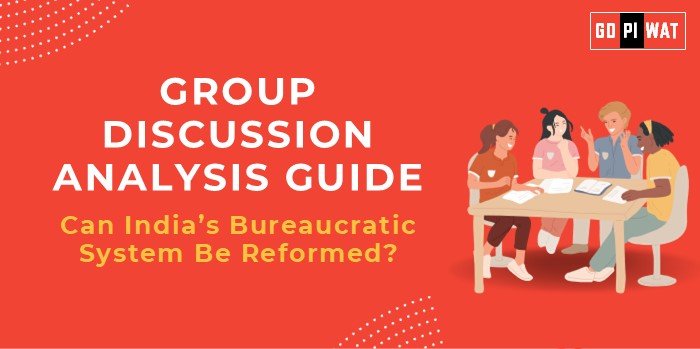📋 Group Discussion (GD) Analysis Guide: Can India’s Bureaucratic System Be Reformed?
🌐 Introduction to India’s Bureaucratic System
- 📖 Opening Context: India’s bureaucratic system, often regarded as the backbone of its governance, has faced growing scrutiny for its efficiency and adaptability in a rapidly changing global landscape. Reforming this structure has been a recurring theme in public and political discourse.
- 🌍 Topic Background: Established during British rule, India’s bureaucratic system was designed to manage colonial administration. Despite its evolution post-independence, it is frequently criticized for being slow, rigid, and overly hierarchical. Recent reform initiatives, such as digitization and lateral entries, highlight the urgency of modernization.
📊 Quick Facts and Key Statistics
- 📉 Global Ranking: India ranks 132 out of 190 in the World Bank’s Ease of Doing Business Report, citing bureaucratic hurdles.
- ⏳ Efficiency Metrics: Administrative processes often require 2-3x more time compared to global averages.
- 📥 Lateral Entry Initiative: Over 20 professionals inducted at joint secretary level in recent years to improve efficiency.
- 📊 Public Trust: Surveys indicate only 38% of citizens are satisfied with bureaucratic services (Lokniti-CSDS, 2023).
🤝 Stakeholders and Their Roles
- 🏛️ Government: Initiates policy and structural reforms like Mission Karmayogi.
- 👩💼 Civil Servants: Execute policies and ensure public service delivery.
- 👥 Citizens: Act as recipients and evaluators of administrative services.
- 🏢 Private Sector and NGOs: Provide models of efficiency and innovation.
🏆 Achievements and Challenges
✨ Achievements:
- ✅ Implementation of Direct Benefit Transfers (DBT): Reduced leakages by ₹2.7 lakh crore.
- 📄 Adoption of e-governance: Programs like DigiLocker have streamlined processes.
- 📈 Increased accountability: RTI and public grievance portals have enhanced transparency.
⚠️ Challenges:
- 🛑 Red Tape: Prolonged decision-making impedes development.
- ⚖️ Corruption: India scores 40/100 on Transparency International’s Corruption Perceptions Index.
- 📉 Resistance to Change: Traditional hierarchies hinder innovation.
🌍 Global Comparisons:
- 🇪🇪 Estonia: With its digitized bureaucracy, processes permits within minutes, showcasing efficiency.
📄 Case Study: Rajasthan’s e-Mitra platform revolutionized service delivery, cutting processing times by 50%.
💡 Structured Arguments for Discussion
- 📢 Supporting Stance: “Reforms like e-governance and lateral entries show that the system is adaptable to change.”
- ❌ Opposing Stance: “Deep-seated corruption and lack of accountability make systemic reforms nearly impossible.”
- ⚖️ Balanced Perspective: “While reforms show promise, resistance from entrenched interests must be addressed to ensure meaningful change.”
📌 Effective Discussion Approaches
🎯 Opening Approaches:
- 📊 “India ranks poorly on efficiency metrics, yet programs like DBT have proven transformative.”
- ❓ “Can India adopt a model like Estonia’s to simplify bureaucratic functions?”
🔄 Counter-Argument Handling:
- 🛠️ Acknowledge corruption but cite success stories like Rajasthan’s e-Mitra.
- 📖 Address slow implementation but highlight the potential of Mission Karmayogi.
📚 Strategic Analysis of Strengths and Weaknesses
- 💪 Strengths:
- 📋 Extensive reach and foundational structure.
- ✅ Success stories like DBT.
- ❌ Weaknesses:
- ⚖️ Corruption.
- 📉 Inefficiency and resistance to innovation.
- ✨ Opportunities:
- 🌐 Digital transformation.
- 📜 Lateral entries and global benchmarks.
- ⚠️ Threats:
- 📢 Political interference.
- 👥 Public distrust.
🎓 Connecting with B-School Applications
🌐 Real-World Applications:
- 📊 Policy analysis, operations strategy, and digital transformation projects.
❓ Sample Interview Questions:
- ❓ “What reforms would you prioritize to make the Indian bureaucracy more efficient?”
- 💡 “How can private-sector practices influence public administration in India?”
📈 Insights for Students:
- 📖 Opportunities for internships in policy think tanks or e-governance projects.


